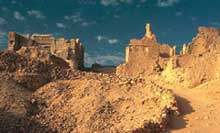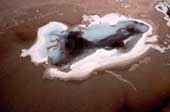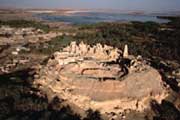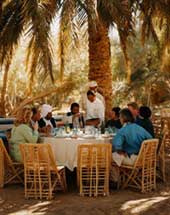|
With a population of
about 23,000, Siwa, the most inaccessible of all Egypt's oasis
until very recently, is also one of the most fascinating, lying
some 60 feed below sea level.
 The area has a nice climate, chilly in winter, hot in the summer
and moderate in the spring and autumn. To the west of the town
lies the Siwa Lake which is a large, saltwater lake. The area is
also famous for its springs, of which there are approximately
1,000. The water is sweet, and is said to have medical
properties. The area is also famous for its olives, and is one
of the most beautiful landscapes in Egypt. Olives oil is still
made in the area by crushing the olives from the 70,000 olive
trees in the area with stones. In fact, the area is also well
known for its crafts, particularly woven cloth, which is unique
in Egypt. The area has a nice climate, chilly in winter, hot in the summer
and moderate in the spring and autumn. To the west of the town
lies the Siwa Lake which is a large, saltwater lake. The area is
also famous for its springs, of which there are approximately
1,000. The water is sweet, and is said to have medical
properties. The area is also famous for its olives, and is one
of the most beautiful landscapes in Egypt. Olives oil is still
made in the area by crushing the olives from the 70,000 olive
trees in the area with stones. In fact, the area is also well
known for its crafts, particularly woven cloth, which is unique
in Egypt.
Siwa, like the other Western Oasis, has had a number of
different names over the millenniums. It was called Santariya by
the ancient Arabs, as well as the Oasis of Jupiter-Amun,
Marmaricus Hammon, the Field of Palm Trees and Santar by the
ancient Egyptians..
We believe it was occupied as early as Paleolithic and Neolithic
times, and some believe it was the capital of an ancient
kingdom. During Egypt's Old Kingdom, it was a part of Tehenu,
the Olive Land.
In many respects, the Siwa Oasis has little in common with the
other Western Oasis. The Siwan people are mostly Berbers, the
true Western Desert indigenous people, who once roamed the North
African coast between Tunisia and Morocco. They inhabited the
area as early as 10,000 BC, first moving towards the coast, but
later inland as other conquering invaders arrived.
In fact, there is almost nothing known of the Siwa Oasis during
Egypt's ancient history. There have been no monuments discovered
dating from the Old, Middle or New Kingdoms. It may have been
colonized during the reign of Ramesses III, but evidence only
exists beginning with the 26th Dynasty that it was part of the
Egyptian empire. It was then that the Gebel el-Mawta Necropolis
was established, which was in use through the Roman Period. Some
sources maintain that it remained an independent Sheikhdom ruled
by a Libyan tribal chief until Roman times. The two temples that
we know of, both dedicated to Amun, were established by Ahmose
II and Nectanebo II.
 Yet just exactly how integrated it was in the Egyptian realm is
questionable. One of the most notable and interesting stories in
Egyptian history involves Cambyses II, who apparently had
problems with the Oasis. He sent an army to the Oasis in order
to seize control, but the entire caravan was lost to the desert,
never arriving at Siwa. To this day, the event remains a
mystery, though tantalizing clues seem to be popping up. Yet just exactly how integrated it was in the Egyptian realm is
questionable. One of the most notable and interesting stories in
Egyptian history involves Cambyses II, who apparently had
problems with the Oasis. He sent an army to the Oasis in order
to seize control, but the entire caravan was lost to the desert,
never arriving at Siwa. To this day, the event remains a
mystery, though tantalizing clues seem to be popping up.
It was the Greeks who made the Siwa Oasis notable. After having
established themselves in Cyrene (in modern Libya) they
discovered and popularized the Oracle of Amun located in the
Siwa Oasis, and at least one of the greatest stories told of the
Oasis concerns the visit by Alexander the Great to the Oracle.
Almost immediately after taking Egypt from the Persians and
establishing Alexandria, Alexander the Great headed for the Siwa
Oasis to consult the now famous Oracle of Amun. This trip, made
with a few comrades, is well documented. He was not the first to
experience problems in the desert, as whole armies before him
had been lost in the sand. The caravan got lost, ran out of
water and was even caught up in an unusual rainstorm. However,
upon arrival at the Oasis and the Oracle of Amun, Alexander was
pronounced a god, an endorsement required for legitimate rule of
the country.
Cleopatra VII may have also visited this Oasis to consult with
the Oracle, as well as perhaps bath in the spring that now bears
her name. However, by the Roman period, Augustus sent political
prisoners to the Siwa so it too, like the other desert oasis,
became a place of banishment.
Christianity would have had a difficult time establishing itself
in this Oasis, and most sources agree that it did not. However,
Bayle St. John says that in fact the Temple of the Oracle was
actually turned into the Church of the Virgin Mary. The Romans
used to banish church leaders to the Western Oasis and to Siwa.
By 708 AD, Islam came to the Oasis , the army of which was
several times defeated by the Siwans . It was probably not until
1150 AD that Islam finally took hold in the Siwa Oasis.
 However, by 1203 we are told that the population of the Siwa
Oasis had declined to as low as 40 men from seven families due
to constant attacks and particularly after a rather viscous
Bedouin assault. In order to found a more secure settlement,
they moved from the ancient town of Aghurmi and established the
present city called Shali, which simply means town. This new
fortified town was built with only three gates. However, by 1203 we are told that the population of the Siwa
Oasis had declined to as low as 40 men from seven families due
to constant attacks and particularly after a rather viscous
Bedouin assault. In order to found a more secure settlement,
they moved from the ancient town of Aghurmi and established the
present city called Shali, which simply means town. This new
fortified town was built with only three gates.
One of the main historical references we have on the Siwa Oasis
is called the "Siwan Manuscript" which was written during the
middle ages and serves as a local history book. It tells us of a
benevolent man who arrived in the Oasis and planted an orchard.
Afterward, he went to Mecca and brought back thirsty Arabs and
Berbers to live in the Oasis, where he established himself,
along with his followers in the western part of Shali.
Unfortunately, there seems to have almost immediately been
problems between the original inhabitants, who were later known
as the Easterners, and the new families “western families” who
to this day are proud to be described as "The Thirty". The
conflicts between the two sides became legendary, and sometimes
rose into short, but intense violence.
Obviously, if the Siwans could not get along with each other,
they surely had trouble accepting outsiders.
When, in 1819, Mohammed Ali, the founder of modern Egypt, began
his conquest of the Western Oasis, he sent around 1,300 troops
to the Siwa Oasis .The ensuing battle lasted for three hours,
but the Siwans this time were no match for modern artillery.
They had to yield to this superior force. By about 1834, The
Siwa Oasis was considered to be safe for travel.
 During the two world wars considerable problems were caused for
the Oasis. The Siwa was really caught up between opposing forces
during World War I. Now, the Siwans found themselves in the
middle of the Italians and the British During the two world wars considerable problems were caused for
the Oasis. The Siwa was really caught up between opposing forces
during World War I. Now, the Siwans found themselves in the
middle of the Italians and the British
v
During the remainder of the war, the Siwa became a tourist
attraction .This was the beginning of real tourism to the Oasis,
and visitors had their choice between a nine day tour by rail
and coach from Mersa Matruh or a month long camel safari that
connected with the Wadi Natrun and the Qattara Depression.
During World War II, Siwa again played an important role. Most
of that war saw the Siwa occupied with Allied troops consisting
mainly of British, Australians and New Zealanders. It was closed
to none military visitors. However, it was bombed by the
Italians who had occupied Libya, Afterwards, visitation to the
Siwa was restricted for a number of years.
Today, the Siwa, while not a heavily trafficked tourist
destination, welcomes those that it receives.
Siwans have their own culture and customs and they speak a
Berber language, called Siwi, rather than Arabic. Interestingly,
each October there is a three-day festival during which Siwans
must settle all of their past year's disputes.a
Popular Safari Places in Western Desert : |